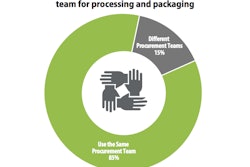
A similar feeling creeps over me now and then when I look out over today’s packaging landscape. It seems to be morphing in a whirlwind of market changes, some large and some small, but all significant in one way or another. Among the recent developments suggesting that the storm clouds of packaging change are rumbling:
• The emergence and expansion of a “digital revolution” in business. MIT Sloan School of Management professors Andrew McAfee and Erik Brynjolfsson, in their latest book, Machine, Platform, Crowd: Harnessing our Digital Future (W. W. Norton & Co.), provide a view of the not too distant future in which machines enabled with artificial intelligence (AI) make smarter operational choices than humans. It is a startling revelation for packaging professionals, implying as it does that selecting the best equipment for a specific packaging application could best be left to experts collaborating with smart machines, not to humans alone. The problem with this prediction where packaging is concerned is that AI machines need tons of data to do their best work. That kind of operational data on equipment performance over time is still a relatively rare commodity in the packaging business. It’s still a place where reliable TCO (total cost of ownership) is still a somewhat novel concept, a place where nothing provides more assurance of correct choice than a first-hand chance to monitor equipment performance and discuss it with a skilled, experienced operator who’s not beholden to you or the seller.
• AMZN: US (NASDAQ GS), recently trading at $1011 per share, is still hungry. That makes a lot of people nervous. Even before Amazon plunked down $13.7 billion to buy Whole Foods, Amazon was generating fear and awe in the marketplace. It has come a long, long way from the days when it was operating under the codename “Big River,” quietly building up the case packing capabilities of its budding book business. Amazon’s grocery business is budding now. And a lot of people are wondering exactly how it will flower. McCormick Foods, for one, thinks the Amazon/Whole Foods juggernaut “probably has more opportunity than risk,” helping the spice giant expand its Whole Foods presence where its spices and seasonings “are pretty light” and “under represented,” according to McCormick CEO Lawrence Kurzius.
In a less than flattering assessment of Amazon entitled “Amazon’s Stranglehold: How the Company’s Tightening Grip is Stifling Competition, Eroding Jobs and Threatening Communities,” the Institute for Local Self Reliance (ILSR) asserts that “Amazon captures nearly one in every two dollars that Americans spend online. Amazon sells more books, toys, and by next year, apparel and consumer electronics than any retailer online or off, and is investing heavily in its grocery business. As a retailer, its market power now rivals or exceeds that of Walmart, and it stands only to grow: Within five years, one-fifth of the U.S.’s $3.6 trillion retail market will have shifted online, and Amazon is on track to capture two-thirds of that share…
“Amazon increasingly controls the underlying infrastructure of the economy. Its Marketplace for third party sellers has become the dominant platform for digital commerce. Its Amazon Web Services division provides the cloud computing backbone for much of the country, powering everyone from Netflix to the CIA. Its distribution network includes warehouses and delivery stations in nearly every major U.S. city, and it’s rapidly moving into shipping and package delivery for both itself and others. By controlling this critical infrastructure, Amazon both competes with other companies and sets the terms by which these same rivals can reach the market.”
• Glass is the material from which the most surprising new package in the dairy case is made. Yes, we’re talking about Oui, the French-style yogurt sold by General Mills in glass pots with laminated foil lids. Revolutionary? It is by American standards, although the French and their European confreres have been serving it that way for years.
• “Unique” describes another refrigerated packaging standout, Pillsbury’s Best Pizza Dough, which is rolled up in parchment paper and packed in peel-open thermoformed trays. It’s a radical departure from the composite cans we’ve associated with Pillsbury’s refrigerated dough products for years.
Dorothy had the Scarecrow, the Tin Man, and the Cowardly Lion to guide her through the Emerald City. Who will guide packaging professionals through the swirling winds of change they now face?
Ben Miyares, Packaging Sherpa, is a packaging market and technology analyst and is president of The Packaging Management Institute, Inc. He can be reached at [email protected].

























